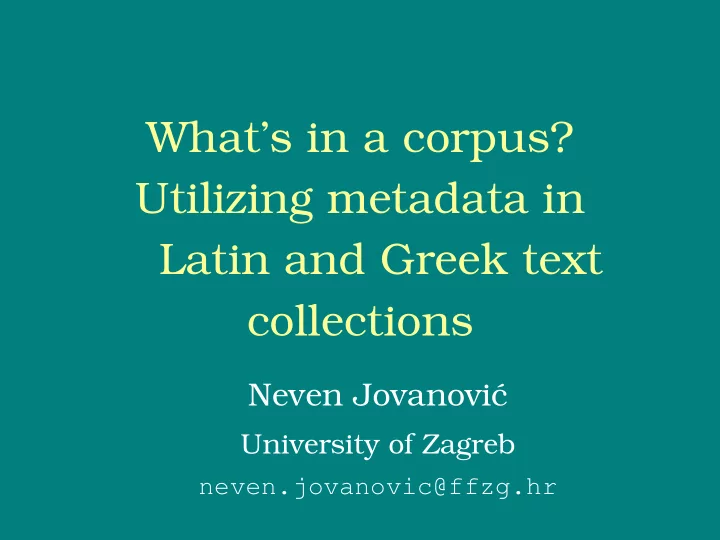

What’s in a corpus? Utilizing metadata in Latin and Greek text collections Neven Jovanović University of Zagreb neven.jovanovic@ffzg.hr
Greek and Latin text collections Greek and Latin Perseus (internet, free access) Greek TLG (Thesaurus linguae Graecae; CD + internet); PHI (Greek inscriptions, documentary papyri; CD + internet, commercial) Latin Bibliotheca Teubneriana Latina (CD, commercial); Library of Latin Texts (CLCLT5; CD, commercial); PHI Latin library (CD + internet, commercial); IntraText Digital Library (internet, free access); The Latin Library (internet, free access); Itinera electronica (internet, free access); Thesaurus Linguae Latinae (a dictionary; CD, commercial)
What Greek and Latin text collections are not A corpus is a collection of pieces of language text in electronic form, selected according to external criteria to represent, as far as possible, a language or language variety as a source of data for linguistic research. (Sinclair 2005)
Maximize number of users Maximize number of uses
... a library? But libraries have catalogues. Catalogues enhance libraries.
Users of Greek and Latin text collections Learners Researchers
A learner's experience
A researcher's experience
A proposal Design a collection of texts in such a way to: a) help learners orientate, and learn what is inside b) help researchers ask complex questions
Questions expected — In which metre are those poems? — How do I search just the poems in hendecasyllables? — Which texts in the collection are letters? — How do I search just the letters in the collection? — Which texts in the collection were produced in first century b. C? — How do I search just the texts produced in first century b. C?
Problems expected — There are too many texts! — How do we find metadata? — How do we actually do it? — Where do we find an army of coders?
What is already around?
(Old) scholarship as source of metadata
Chicago Homer
TLG / PHI with Diogenes
TLG / PHI with Diogenes
Perseus under PhiloLogic
Vindolanda tablets online
Croatiae auctores Latini (CAuLa) ca. 300.000 words pilot short texts, long texts, poetry, prose, literature, functional texts (e. g. notarial documents) until now: uncentralised, undigitised, sometimes unindexed, not easily (world wide) accessible or searchable, not always reliably edited...
Croatiae auctores Latini (CAuLa) Search and browse by: Auctores (AZ) Tempora (e. g. 14001950) Loca (e. g. Dubrovnik, Split, Trogir)
Croatiae auctores Latini (CAuLa) Search and browse by: Genera Poesis Prosa
Croatiae auctores Latini (CAuLa) Genera Poesis epica elegiaca epigrammata eclogae saturae
Croatiae auctores Latini (CAuLa) Themata funeraria amicitia amores antiturcica ...
Croatiae auctores Latini (CAuLa) Damjan Beneša (Dubrovnik, around 1500), De morte Christi (10 books, 8300+ verses) Liber I Opening scene (vv. 1-30). Before Easter: everywhere sorrow. The poet thinks about faraway places, about Christ's passion and death. Jerusalem: Christ is being taken to Pilates' palace. The poet sees a vision of Christ hanging on the cross, his Mother grieving Invocation (vv. 31-43): one who sings about Christ will earn a place in heaven; why did the Virgin bear a son, etc.
CAuLa: sample queries What did people write about when they wrote in Latin in Split between 1500 and 1600? How did poetry about friendship look like in Dubrovnik between 1500 and 1600? In what types of texts is word arma used? Are there types of texts that do not use this word? ...
What do we I need? — Caveat : a theoretically simple task may get quite untractable in real life (standards? searches? references? openness? computer science? etc.) — If possible, use tools that already exist (learn about them) — If possible, connect with projects that already exist (idem) — Attract users, who will also help keep the project alive (corrections? reviews? research? teaching?) — Hear what others think!
Recommend
More recommend